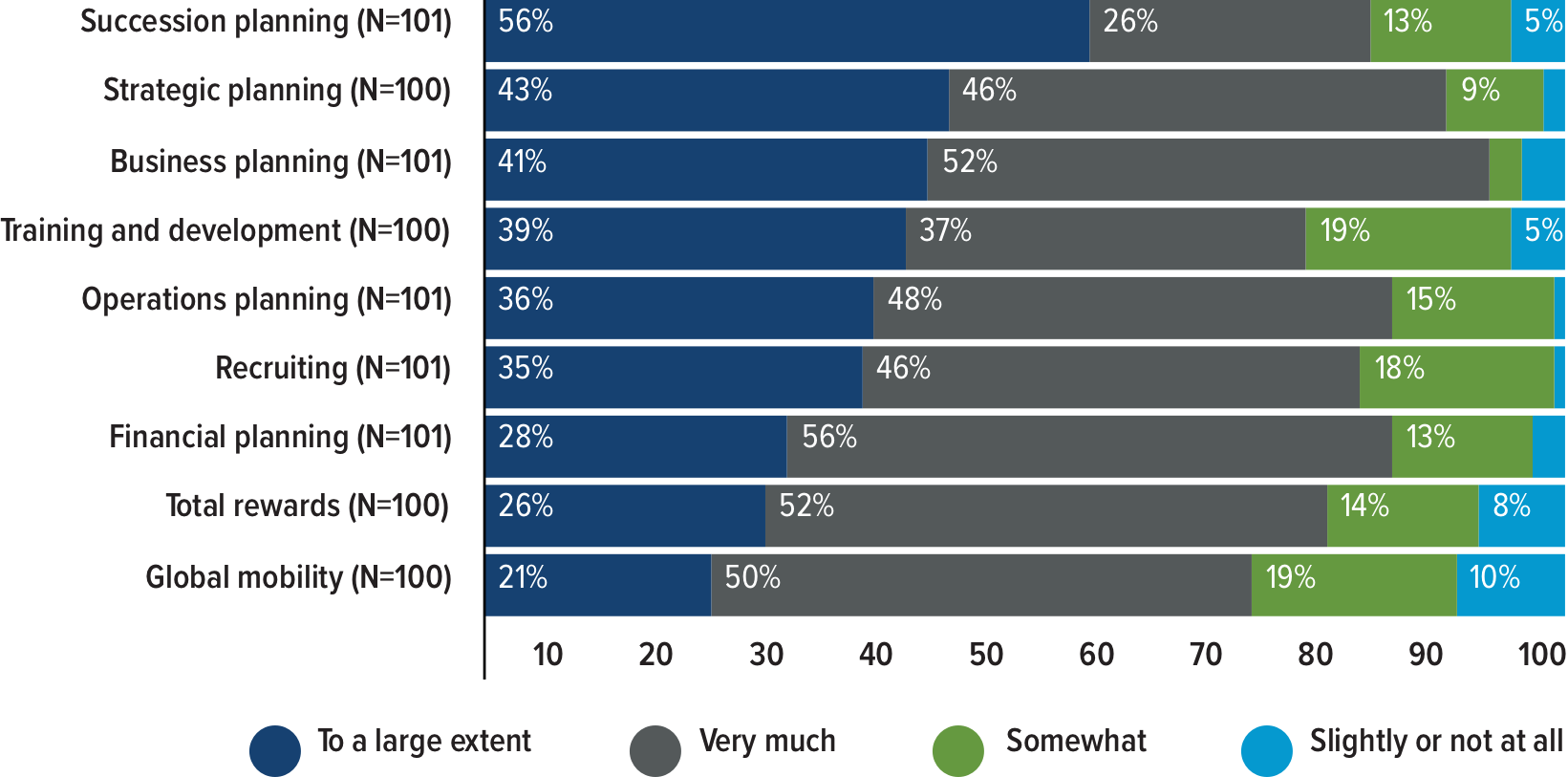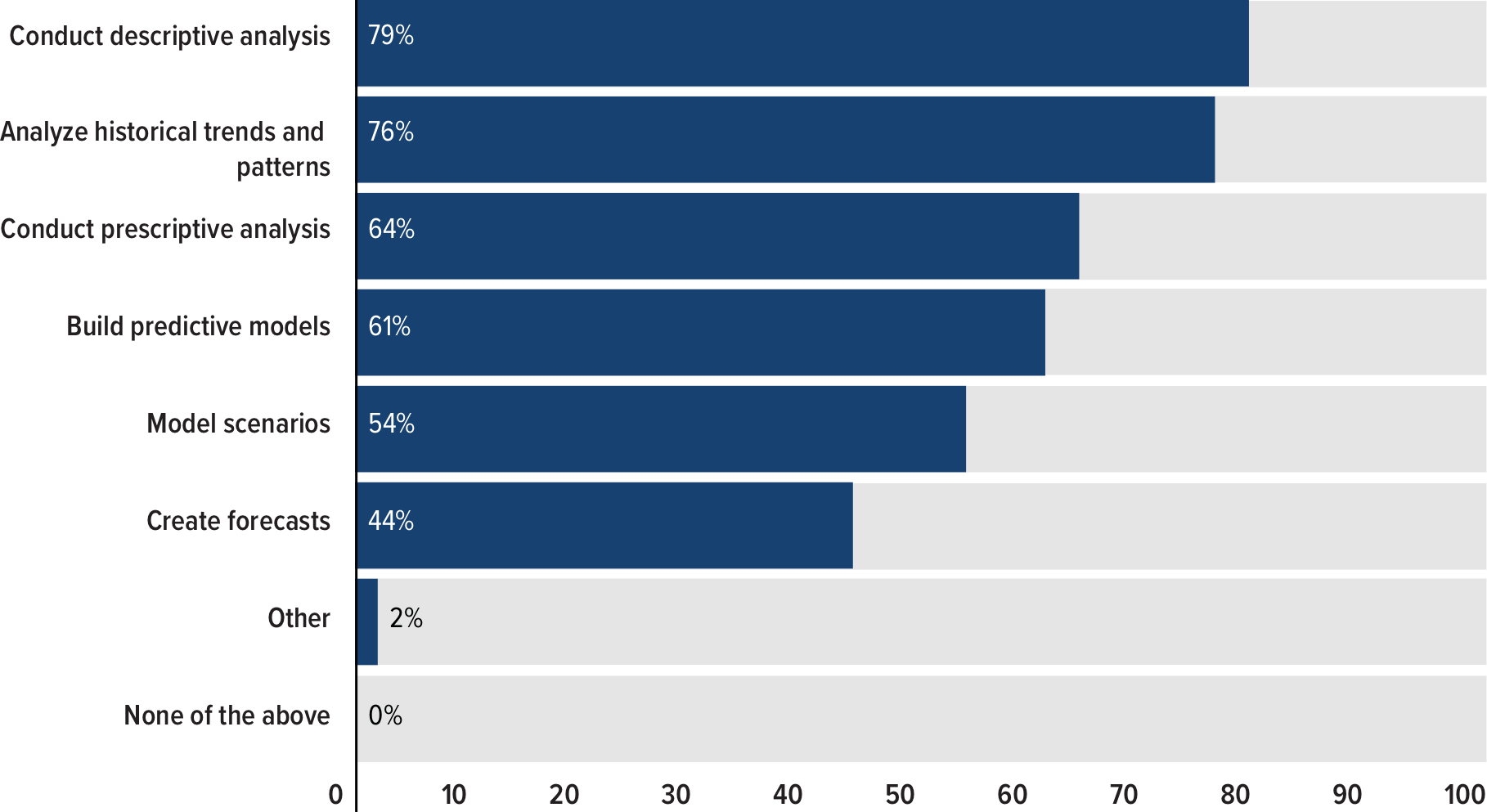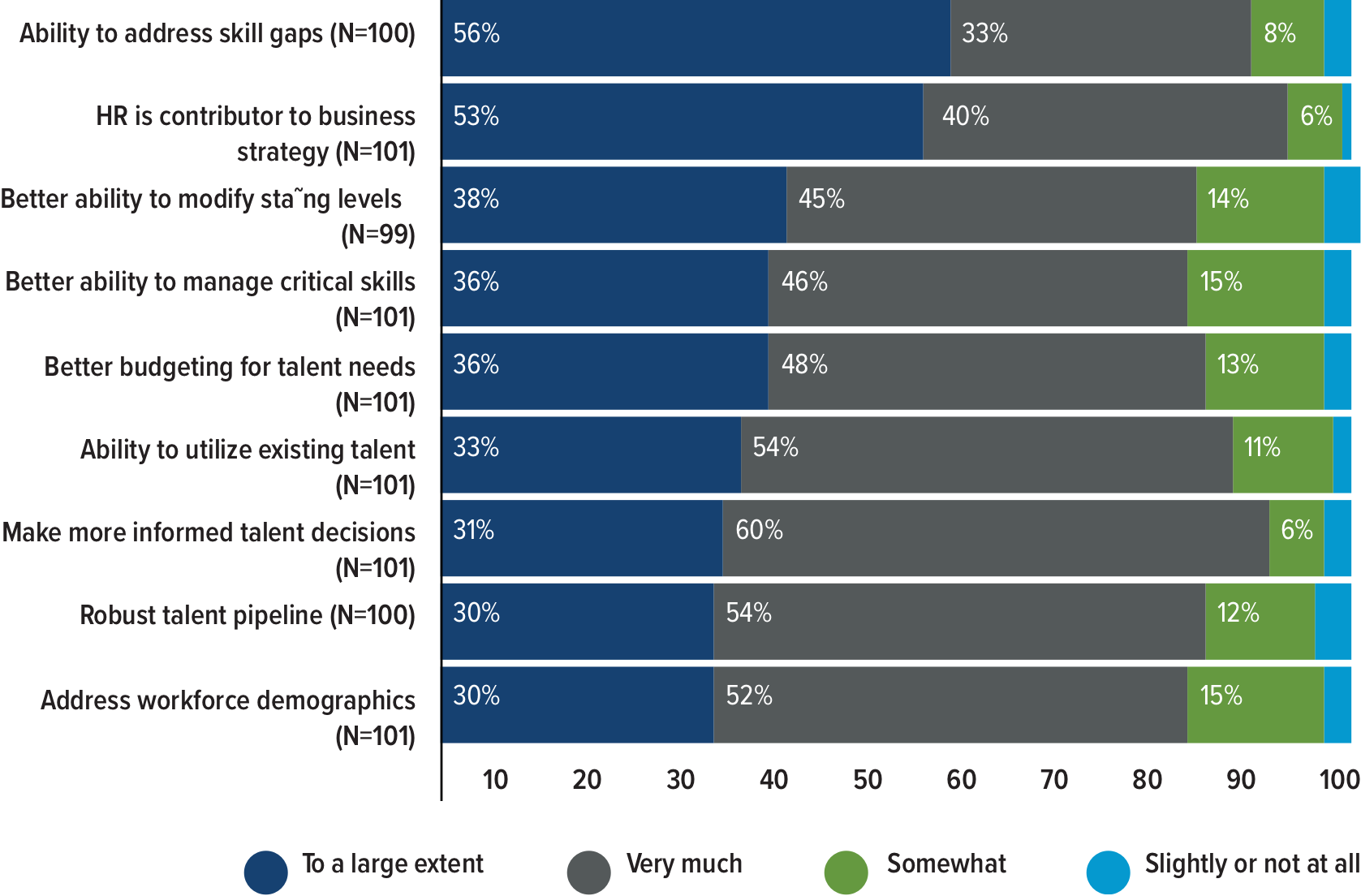How to Modernize Workforce Planning

APQC’s Strategic Workforce Planning study, sponsored by IBM, included:

A survey of 101 organizations with relatively mature strategic workforce planning processes.
Analysis of statistically significant differentiating practices of the top 25 programs based on their reported ability to:
- Effectively create and implement workforce plans,
- Demonstrate ROI from workforce planning, and
- Achieve a range of other positive outcomes.
Interviews with five organizations that exemplify top performance in strategic workforce planning.
Strategic workforce planning is about getting the right people with the right skills in place at the right time in order to fulfill an organization’s mission and goals. And while planning is more difficult given the current pace of change, getting the right talent at the right time is more important than ever in today’s skills-driven, digital economy.
Through APQC’s survey and case study research, we see that rather than turning away from workforce planning because of its difficulty, organizations are using it to address a range of business challenges including: preparing for retirements, closing skills gaps, reducing voluntary turnover, improving workforce utilization, and meeting diversity and inclusion goals.
And, it’s working, with organizations that APQC studied reporting many positive outcomes from their efforts, such as:
- Reduced voluntary turnover,
- Greater workforce ROI,
- More job openings filled internally,
- More robust leadership pipeline,
- Better ability to address skills gaps,
- Better ability to modify staffing levels,
- Better ability to manage critical skills, and
- HR seen as a strategic contributor.
This article presents four common practices among the organizations from our study that are realizing the most positive outcomes from workforce planning.
- Make workforce planning a formal enterprise process.
- Collaborate and assign accountability.
- Use analytics and conversation.
- Be open-minded and flexible.
These practices support effective workforce planning amidst the quick-changing demands of the modern organization.
1. Make Workforce Planning a Formal Enterprise Process.
Our research shows that workforce planning has evolved from being a once-a-year, HR headcount planning exercise to become a formal, year-round business process involving a standard set of steps. The best-in-class workforce planning programs in our study have a standardized, centralized workforce planning process that is integrated with other organizational processes. This helps them to efficiently create plans that align with the latest business needs.
Centralize and Standardize the Process
Centralization and standardization are hallmarks of effective workforce planning processes. The best-in-class programs centralize workforce planning expertise and standardize workforce planning steps. In doing so, they are able to consistently leverage workforce planning best practices across the organization and coordinate planning and implementation when different areas of the organization face similar or complimentary workforce challenges.
For example, Phillips 66 has centralized workforce planning and analytics into a center of excellence (COE) within its HR function. This workforce planning COE is responsible for the design, implementation, and governance of workforce planning and analytics and serves the entire organization.
The United States Department of Agriculture (USDA) Farm Service Agency also has a central strategic workforce planning team that has established a standardized process. The team looks for common issues among program areas, states, and regions that can be addressed in a coordinated way.
At a high-level, best-in-class programs follow a similar set of workforce planning sub-processes: establishing/reviewing the business strategy, conducting a supply/demand analysis, creating the workforce plan, implementing the plan, and measuring outcomes.
The U.S. Geological Survey’s strategic workforce planning process, for example, has the following sub-processes.
- Set the strategic direction. A multidisciplinary team defines a vision for the organization’s future by considering immediate and long-term goals, major planning issues and trends, and anticipated budget changes.
- Identify current supply, future demand, and discrepancies. The team analyzes supply by focusing on a particular function and occupation, identifying baseline workforce and financial data, and examining issues related to diversity. It then analyzes demand by anticipating changes and their impact over the next three to five years. Lastly, the team uses qualitative and quantitative analyses to assess discrepancies between the current state and desired futured state.
- Develop an action plan. The team prioritizes the most critical gaps and determines strategies and specific action items to address them.
- Implement an action plan. Senior managers hold subordinate managers accountable for moving forward on action plans.
- Monitor, evaluate, and review. Managers regularly evaluate the implementation to determine progress in addressing the gaps and adjust the plan as needed.
Integrate with Other Organizational Processes
The strategies that organizations develop in workforce planning involve a wide array of HR stakeholders, from recruiting to compensation and development to retention. They also involve an array of business stakeholders including leaders and managers from other functions as well as business units. This complexity means that workforce planning will suffer if these groups don’t know about the workforce plan until its implementation.
Integrating the workforce planning process with other HR and business processes by engaging leaders, subject matter experts, and other appropriate stakeholders early and often helps ensure that workforce plans are aligned with business objectives. This results in relevant plans that are more likely to get implemented and then yield results the business most needs.
For that reason, most organizations in our study integrate their workforce planning process with other processes such as succession, strategic, business, and operations planning (see Figure 1). Compared to other organizations, organizations with best-in-class workforce planning programs have greater levels of integration between workforce planning and business planning.
Figure 1: Integration of Workforce Planning with Organizational Processes

2. Collaborate and Assign Accountability.
Best-in-class programs go further than just integrating workforce planning with other business processes. They make workforce planning a truly collaborative process. While a centralized team of workforce planning experts is typically accountable for process development and oversight, other areas of the business play a significant role and hold formal accountabilities related to plan creation and implementation.
Collaborate in Plan Creation
One common theme that we observed is that when it comes to creating the workforce plan, business units have significant involvement, often alongside workforce planning teams and business unit-embedded HR partners. Among best-in-class programs, the workforce planning team, HR business partners, and business unit leaders and managers work together to create the workforce plan. Compared to other organizations in our study, organizations with best-in-class programs experienced more involvement from business unit managers during plan creation. This further ensures that the workforce plans that get created address the most current and pressing organization needs. It also helps plans get implemented. Because business unit managers created the plans, they understand their value. They have both the motivation and authority to influence others in the business to carry them out.
For example, at Kaiser Permanente Northern California and the MITRE Corporation, plan creation is a collaborative activity involving executives, middle and upper-middle management, and HR leaders. Executives provide strategic direction. Middle and upper-middle management explain how work occurs on the front lines. And HR leaders offer feedback on forecast assumptions and facilitate dialogue with HR subject matter experts. By marrying workforce planning, business operations, and HR subject matter expertise, workforce planners at these organizations have all the information they need to create relevant and actionable workforce plans.
Assign Accountability for Implementation
Without HR business partner and line manager participation any implementation initiative, such as hiring or training, cannot be fully successful. Therefore, it is important to place ultimate accountability for workforce plan implementation with the business units. A strong differentiator of best-in-class programs is holding HR business partners or business unit line managers accountable for implementing the workforce plan, even as the workforce planning team continues to play an advisory role.
At Kaiser Permanente Northern California, for example, the business units are primarily responsible for the successful implementation of the workforce plan, with the workforce planning team playing a supporting role, meeting with business units on varying schedules from quarterly to monthly and even weekly during intervention implementations.
At the MITRE Corporation, embedded HR business partners have primary responsibility for implementing the plan with involvement from HR areas of expertise such as recruiting, learning, succession, and career planning. The workforce planning team is involved as a technical advisor upon request and tracks results.
3. Use Analytics and Conversation.
Data and analytics hold the promise of providing workforce planners with more precise and up-to-date information on operational requirements and business resources. Our study found that the use of analytics in workforce planning is now ubiquitous: Nearly all organizations in our study use at least some degree of data and analytics in workforce planning. Descriptive analyses (79 percent), analyzing historical trends and patterns (76 percent), and prescriptive analysis (64 percent) are among the most common forms of analysis in workforce planning (see Figure 2).
Figure 2: Types of Analyses Used in Workforce Planning

Compared to other organizations in our study, organizations with best-in-class workforce planning programs have significantly better access to the data needed for workforce planning and they leverage analytics in workforce planning to a significantly greater extent. While they use analytics for a variety of reasons, two key uses are to establish buy-in for the workforce planning process and to foster discussions that yield more relevant and effective workforce plans.
Establish Buy-In
On a broad level, the potential applications of data and analytics has been generating buzz among business leaders, including the C-suite, for some time now. This excitement can be leveraged by workforce planning teams to initiate discussions with business leaders. A common theme across best-in-class programs is the important role that analytics play in opening the door with business leaders and then establishing credibility for the workforce planning process.
Kaiser Permanente Northern California uses analytics to address the short-term workforce problems of business unit leaders which in turn establishes the credibility necessary to engage these leaders in the heavy lifting of longer-term workforce planning. In another example, the workforce planning and analytics COE at Philips 66 provides a quarterly human capital analytics dashboard that helps it start conversations with executives, business leaders, and HR business partners. The six-page report includes key challenges, overall performance, quantitative breakdowns, and a description of workforce trends by business segment.
Drive Impactful Discussions
Ultimately, workforce data opens business unit leaders and managers to having the kind of deep and nuanced dialogue about business needs and workforce requirements that results in more relevant and effective workforce plans. At the MITRE Corporation, the workforce planning team leverages data and analytics to build scenarios based on experience and tenure, forecast and model turnover trends, and provide projections of long-term impacts. The team lead reported that these analyses helped to improve the quality of conversations with business leaders and empowered the organization as a whole to go beyond the numbers themselves to actionable forms of insight. Rather than solely focusing on creating ever more accurate forecasts, they spend time looking at the variables that should go into those forecasts, identifying a range of scenarios, and creating plans and interventions that address these.
4. Be Open-Minded and Flexible.
The modern workforce planning process takes into consideration all workforce segments as well as the full-range of human capital strategies. And, it involves constant monitoring and adjustment.
Consider All Workforce Segments
Given the fast pace at which organizations’ workforce requirements can change, it is important to keep an open mind when starting the workforce planning process. Rather than having a pre-established, set-in-stone group of workforce segments that are the focus of workforce planning from the start, its best to let the organizational strategy, business plans, and workforce analytics determine which areas of the workforce should be included in the workforce plan.
Best-in-class workforce planning programs are significantly more focused on revenue-generating positions in their workforce plans compared to the workforce planning programs at other organizations in our research. This suggests the best-in-class programs are keeping an open mind and adjusting workforce planning as organization strategy and business needs change.
The MITRE Corporation examines the entire workforce but ultimately focuses plans on areas identified in interviews with directors and via scenario and gap analysis. Similarly, the USDA Farm Service Agency’s workforce planning effort is not focused on particular occupations but instead on anticipating what skillsets will support the agency’s mission.
Be Open to the Full Range of Interventions
When creating a strategic workforce plan, organizations can leverage numerous human capital strategies. Among the organizations in our study, the most common gap-closing strategies are developing talent and hiring talent (see Figure 3).
Figure 3: Human Capital Strategies Used in Workforce Planning

Best-in-class workforce planning programs consider the full-range of human capital strategies for closing gaps and they leverage workforce redeployment, work redesign, and contract talent to a greater extent than other organizations. Their integrated, collaborative, and open-minded workforce planning processes provide them with the information and lead time needed to effectively redeploy existing workers and redesign jobs in line with changing business needs.
USDA Farm Service Agency’s workforce plans, for instance, touch all components of the human capital arena, from development to recruitment to knowledge management to engagement and organizational structure and succession planning. In addition, its workforce planners use a sustainability model to consider where people can advance. The model looks at transferable skills and competencies among different occupations so the organization can prepare employees to move into different roles. Focusing training and development on transferable skills and leveraging a wide range of human capital strategies and tactics has ultimately helped the agency to improve retention in its workforce.
Allow for Adjustment
If conditions change, which they increasingly do, organizations need to be prepared to adjust their workforce plans, even when implementation is well underway. This kind of agility is achieved through ongoing engagement between strategic workforce planning teams, HR business partners, business leaders and managers, as well as HR subject-matter experts. Among best-in-class programs, these workforce planning stakeholders are more actively engaged throughout the year compared to other programs. They treat workforce planning as a never-ending process and are continuously monitoring workforce plans and implementation for signs that adjustments need to be made. Their workforce planning stakeholders have regularly scheduled meetings to assess implementation progress and adjust implementation strategies or workforce plans as needed.
The MITRE Corporation considers workforce planning to be an ongoing process; the workforce planning team stays engaged with the business to ensure implementation strategies are working and meeting expectations. This works best when there are monthly or at least quarterly discussions between the workforce planning team and the business. The team supports adjustments to strategies and notifies the business when the organizational outlook or other factors have changed.
Figure 4: How Workforce Planning Will Change in the Next Five Years

What’s Next?
APQC asked study participants how they anticipate that strategic workforce planning will change in the next five years. The results, shown in Figure 4, demonstrate that respondents foresee significant progress across capabilities in meeting strategic goals.
Key Steps for Building a Best-in-Class Workforce Planning Program
- Centralize workforce planning expertise into a team that serves your organization.
- Standardize your workforce planning process.
- Incorporate proven sub-processes: review business strategy, conduct supply and demand analysis, create the workforce plan, implement the plan, and measure outcomes.
- Assign your workforce planning team with accountability for managing and advising on the workforce planning process.

- Assign your business leaders with accountability for workforce plan creation and implementation.
- Conduct workforce planning in tandem with business planning.
- Incorporate managers, and their day-today knowledge of how work gets done, in workforce planning.
- Use data and analytics to initially engage business leaders in workforce planning.
- Use data and analytics to later spur nuanced discussions, among business leaders and managers, regarding future workforce needs and gap closing strategies.
- Consider your entire workforce in planning, but ultimately focus on workforce segments that are anticipated to be business-critical.
- Consider not only hiring and training, but also worker redeployment and work redesign as ways to close skills gaps.
- Revisit workforce plans on at least a quarterly basis and make adjustments as needed.
For best-in-class workforce planning programs, the future looks even brighter. Survey participants representing these programs were significantly more likely to see their future workforce planning processes as being characterized by the following:
- Greater integration of workforce planning with other HR and business processes,
- More investment from the business into the strategic workforce planning process,
- More stakeholder involvement in the process,
- Greater use of real-time data, and
- More accurate forecasts of talent supply and demand.
While there is truly no one-size-fits all approach to strategic workforce planning, at organizations with best-in-class programs it is a continuous process that includes collaboration between HR and business partners, leverages data and analytics to push planning conversations to the next level, and draws from a variety of human capital strategies. Workforce planners at organizations that have embraced these practices find that they are able to craft more effective workforce plans, leverage a more coordinated effort across the organization, and draw from among the most effective approaches to make workforce planning a success.
Elissa Tucker is the principal research lead for human capital management at APQC, a member-based nonprofit specializing in benchmarking and best practices research. She can be reached at etucker@apqc.org.


